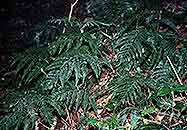Polystichum transkeiense W. Jacobsen
Synonyms |
|
|---|---|
Common name |
|
Description |
Rhizome creeping, 5-10 mm in diameter; rhizome scales 3-15 mm long, pale brown, sometimes dark towards the tip, apex gradually tapering to a point, margin entire to subentire. Fronds spaced 1-3.5 cm apart. Stipe 14-58 cm long, pale straw-coloured, sparsely set with pale brawn hair-tipped scales, c. 5 mm long, becoming glabrous with age. Lamina 25-65 x 24-31 cm, ovate in outline, 2 pinnate to deeply 3-pinnatifid, basal pair of pinnae somewhat reduced. Pinnules variable in outline, usually roughly rhombic, base asymmetrically cuneate, both surfaces glabrous to subglabrous but with a prominent scale at the base of each pinnule, basal margin entire, distal margins toothed. Rhachis rather thin, with a few brown hairlike scales, becoming glabrous with age. Sori round, 0.5-1.0 mm in diameter; indusium shed early and often appearing to be exindusiate. |
Notes | |
Derivation | transkeiense: from Transkei region in the Eastern Cape, where the type specimen was collected. |
Habitat | Deep shade in evergreen forest. |
Distribution worldwide | See African distribution. |
Distribution in Africa |
|
Growth form |
Terrestrial. |
Literature |
|

